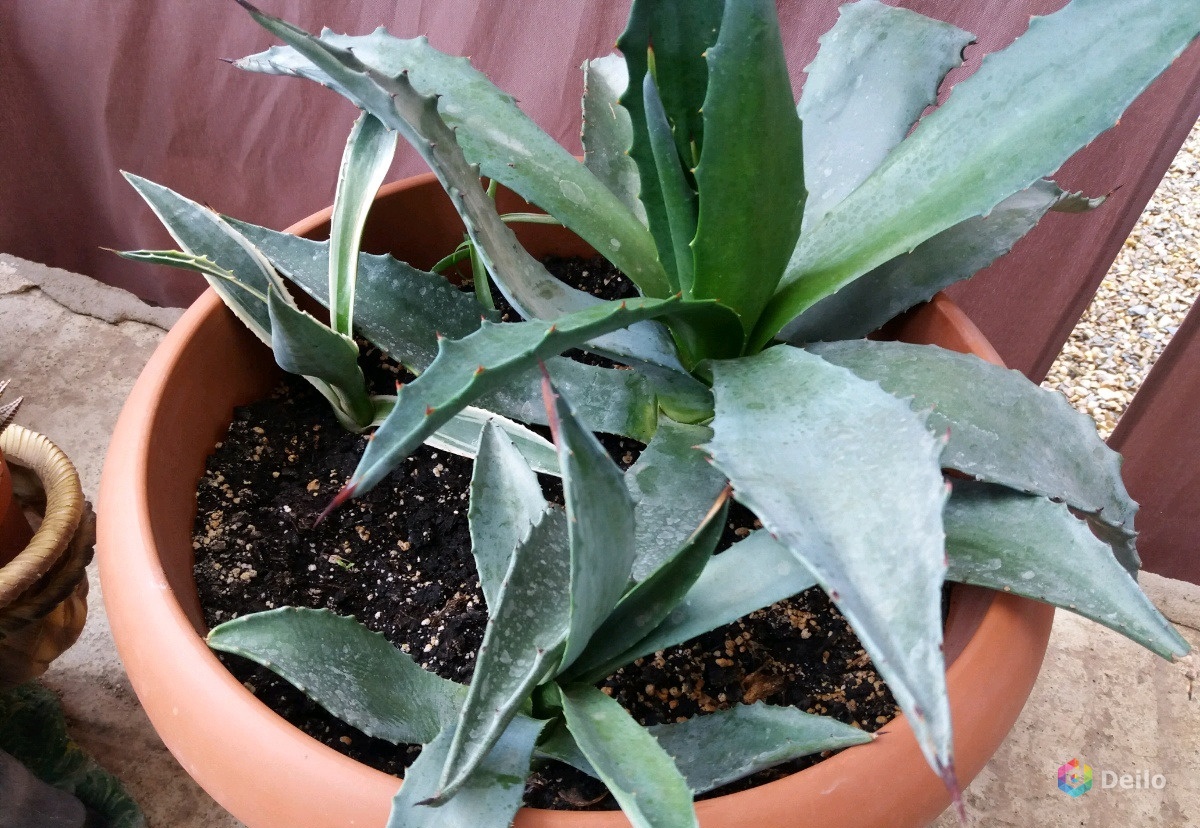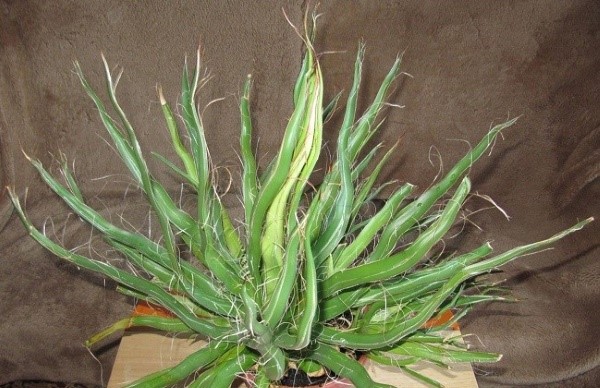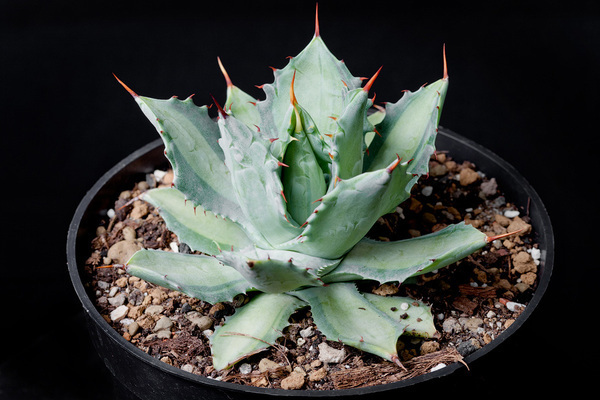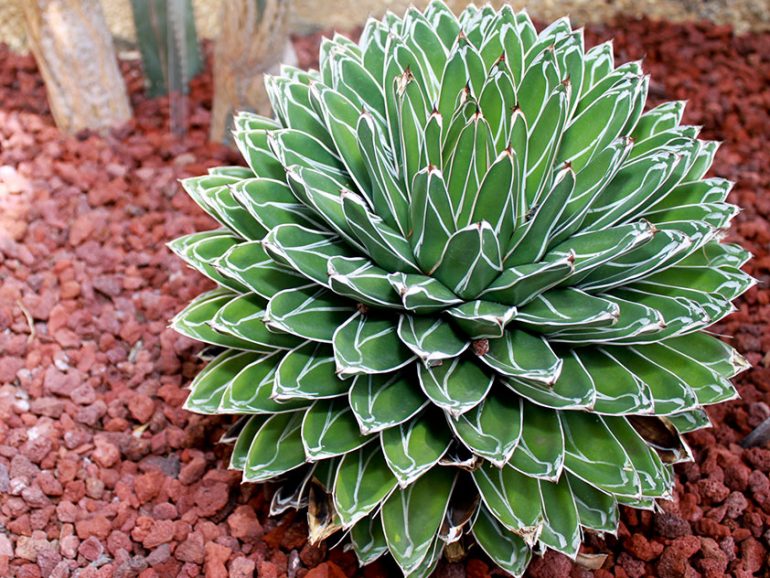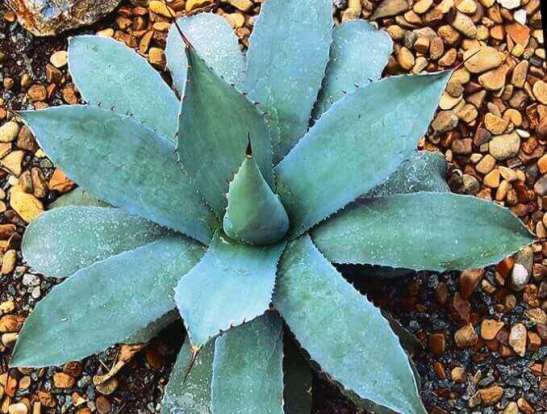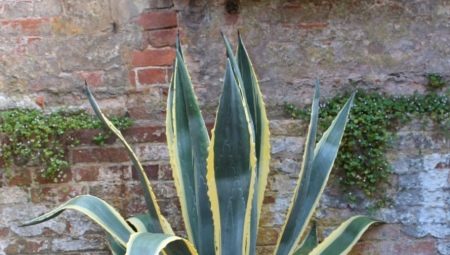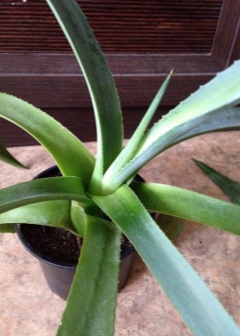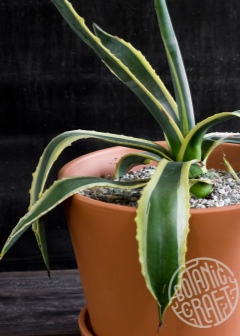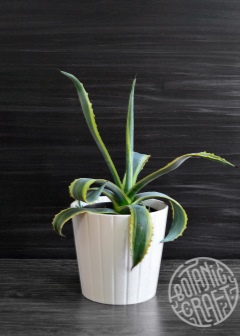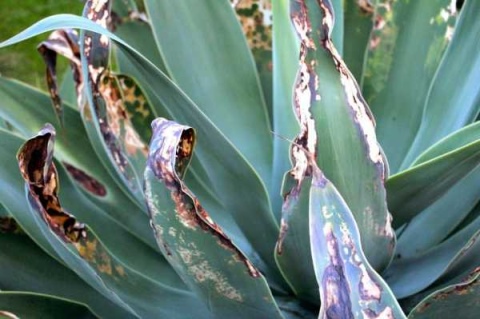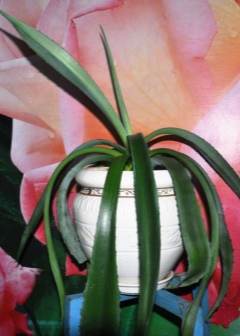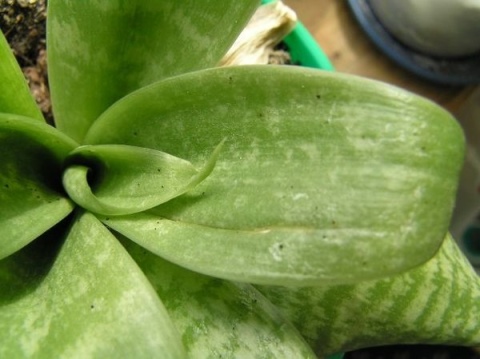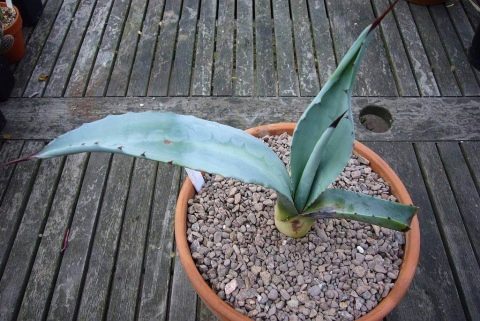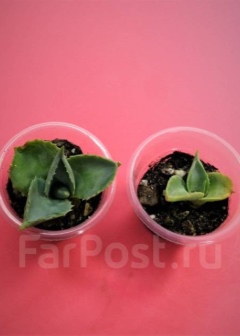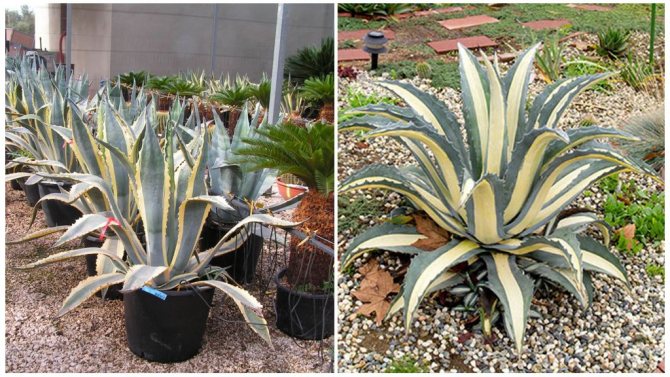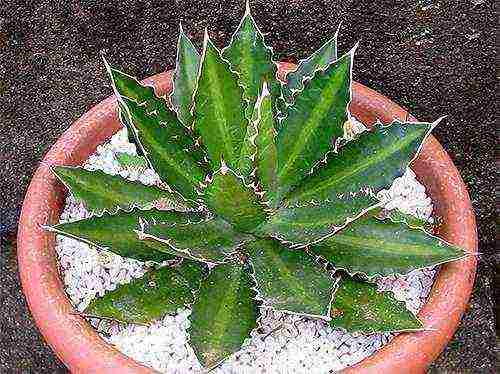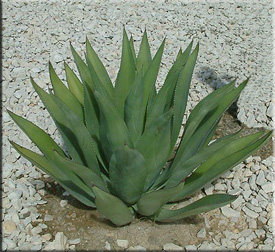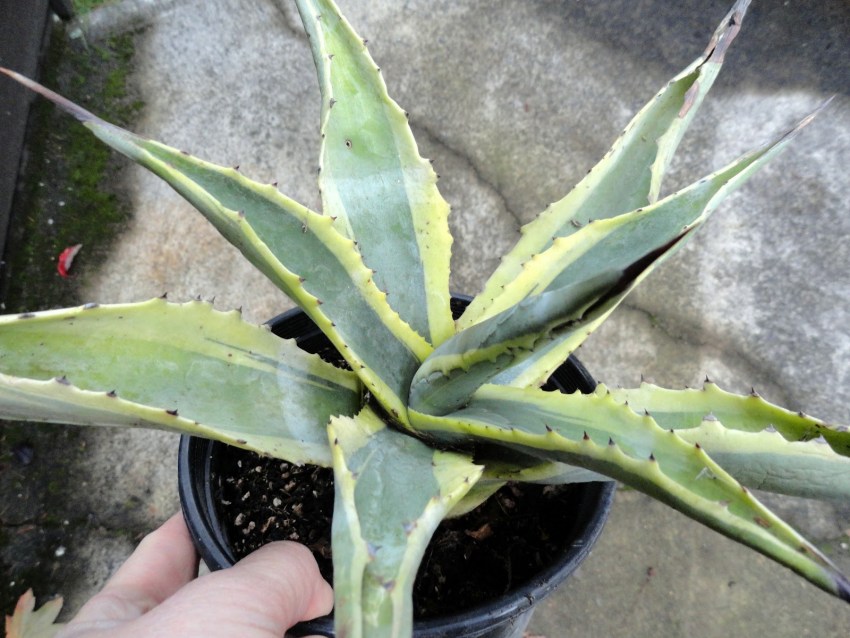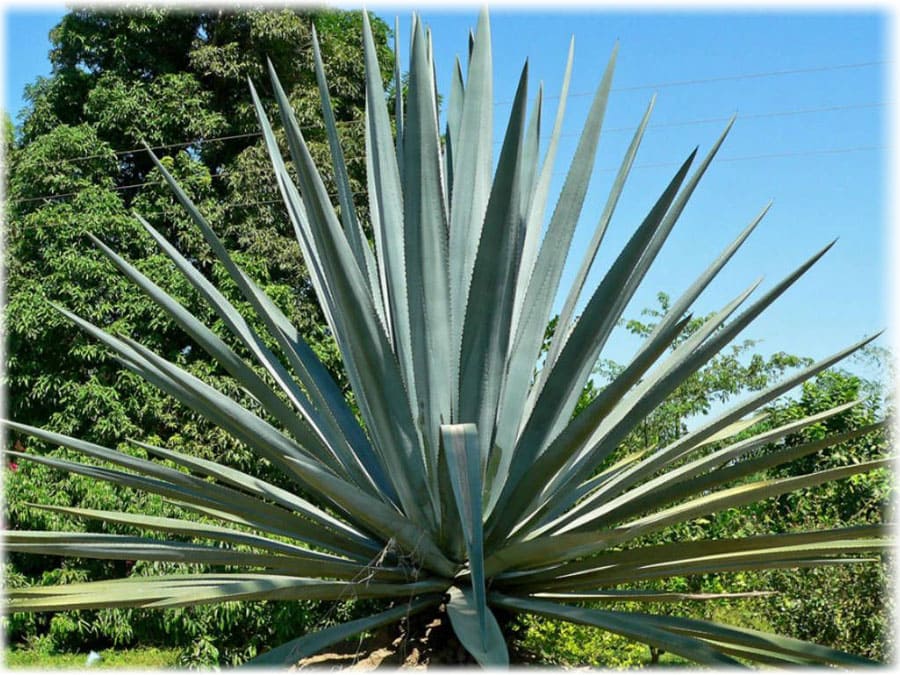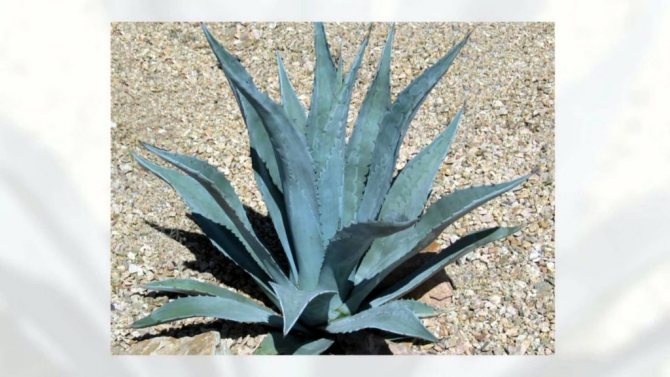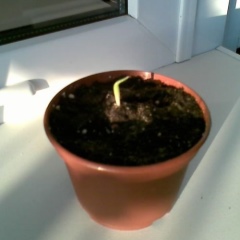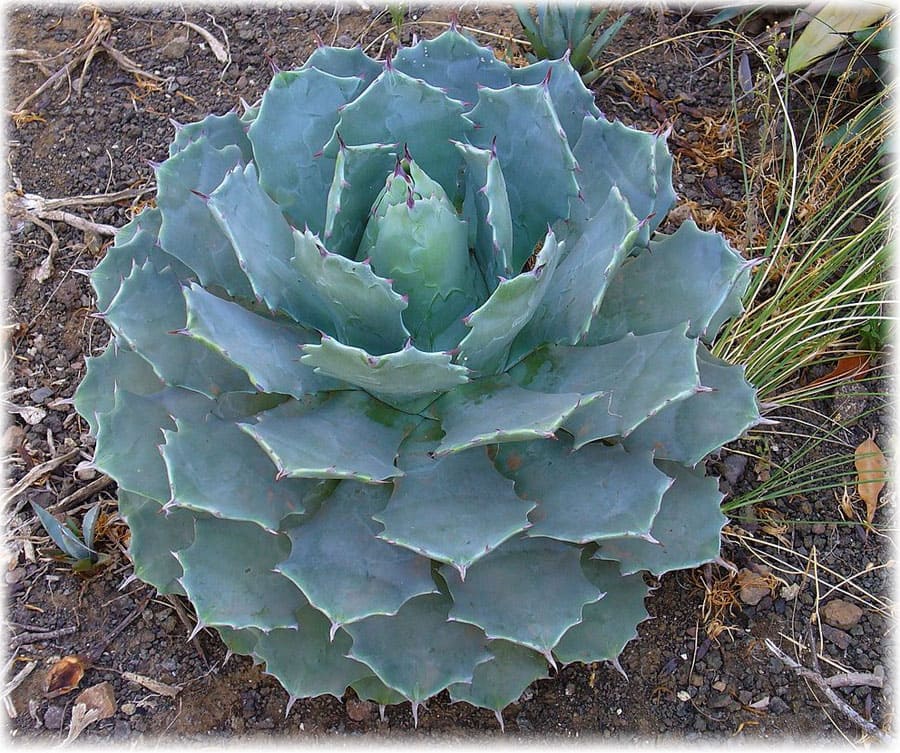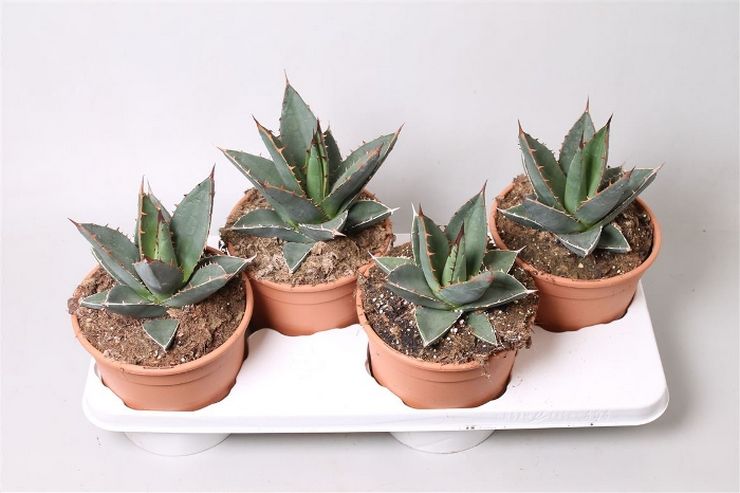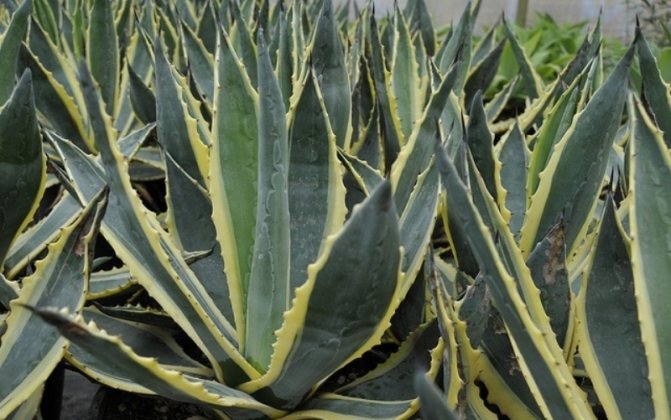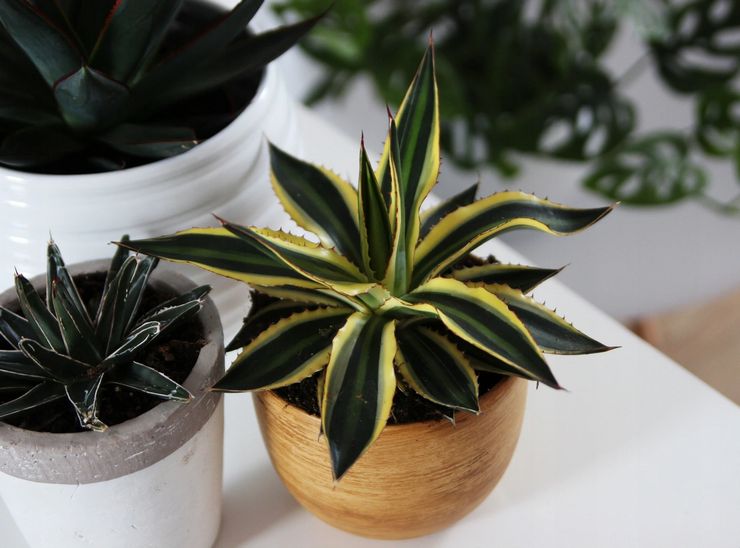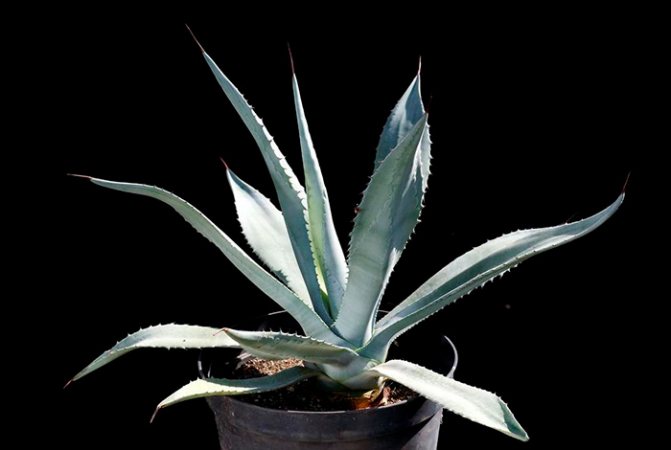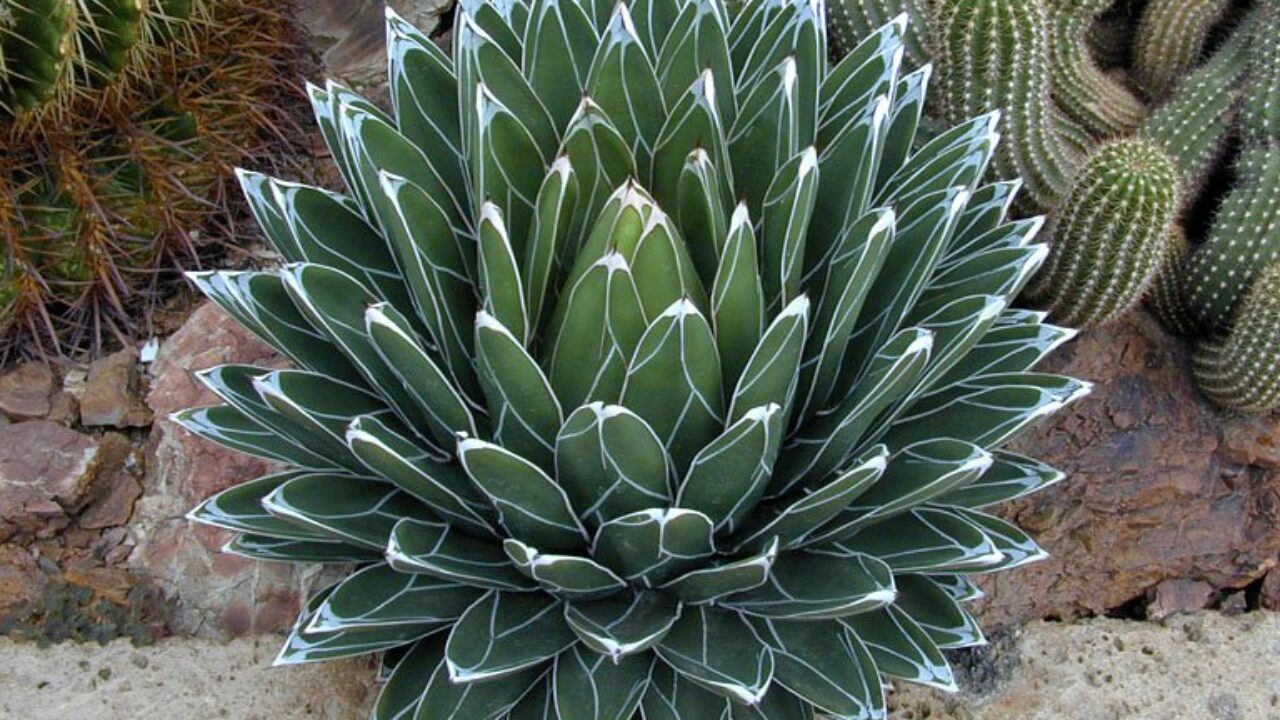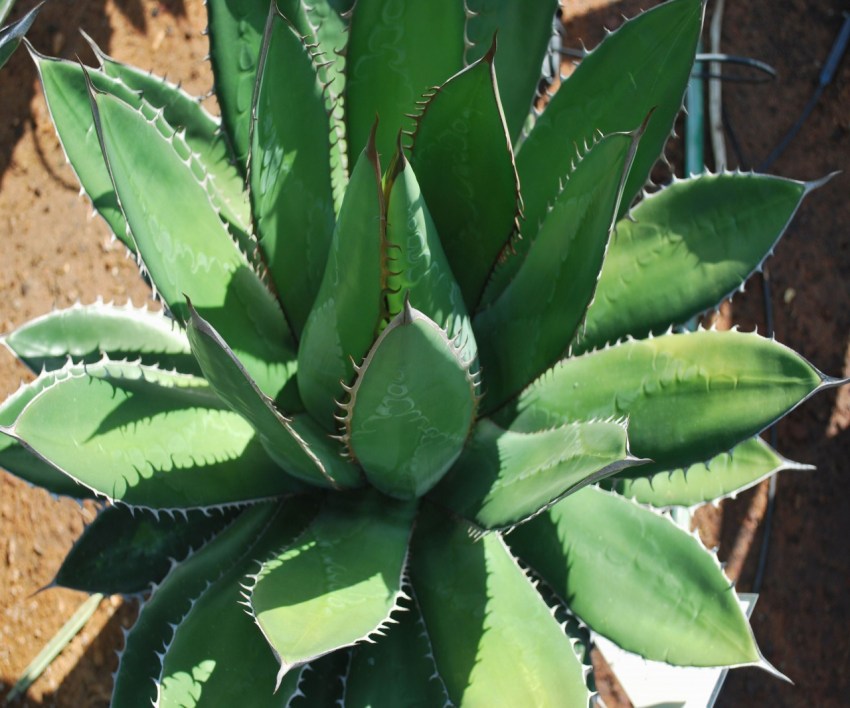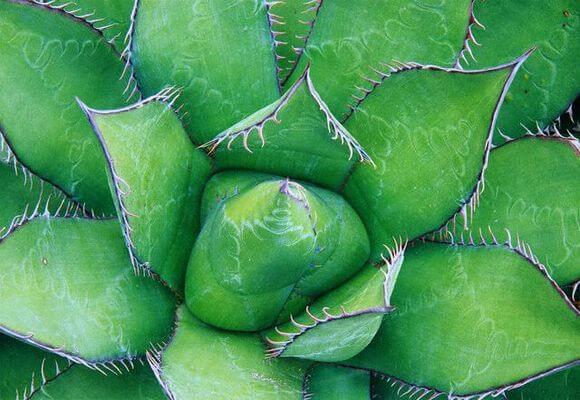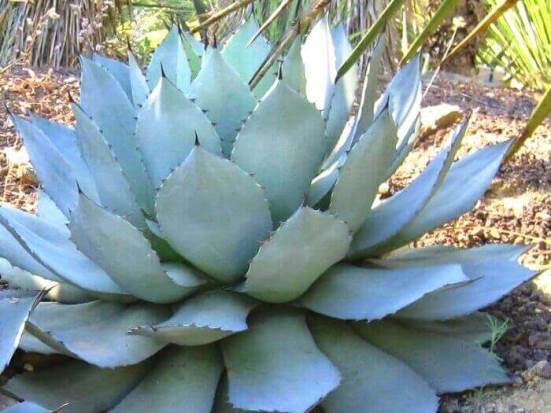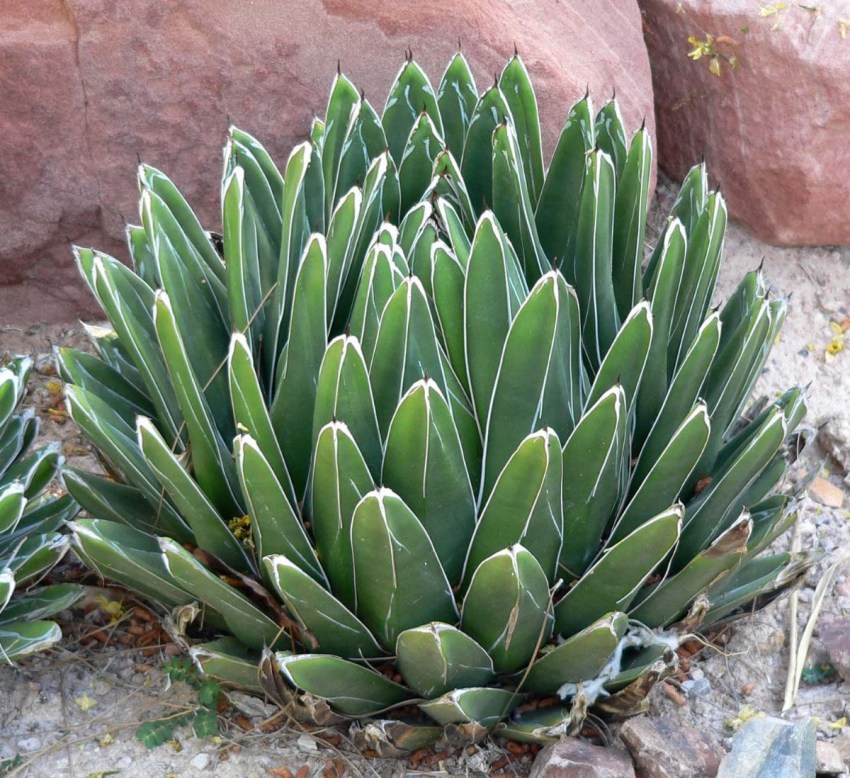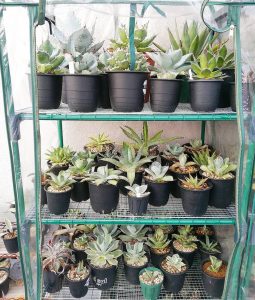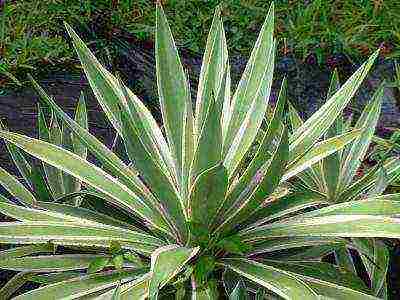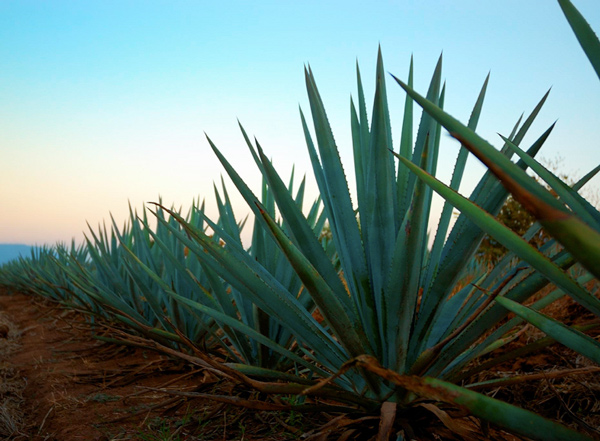Home care
Bloom
Agaves always bloom once, after which they begin to gradually die.
After several months, small shoots will appear near the rhizome, which exfoliate and create their full-fledged plant.
It is difficult to predict exactly when it will bloom.
In nature, some types of Agave begin to produce flowers at the 10-15 years old stage, others when they are 20-30 years old.
There are also those that bloom after 100 years.
The peduncle is quite impressive in size, so within 2 months the plant will delight you with its appearance.
The flower opens gradually, also over several months.
However, it is worth noting that in captivity, that is, at home, American agave blooms extremely rarely.
Features of care after purchase
Having bought an American agave, home care will not cause you any trouble, you just need to water the plant and put it in a place favorable for it.
Lighting
First of all, you need to choose a suitable location for the American agave.
It can be a well-lit space (both in winter and summer).
It is desirable that the window be either on the south, or east, or west side, but in no case on the north.
In summer, it can be taken out into the fresh air, but make sure that it does not get rain.
Temperature
American agave is quite demanding in terms of temperature. The thermometer should not drop below 18 ° C.
It is advisable to keep the room temperature around 24 ° C as it is considered optimal.
Some species are capable of withstanding 10 ° C cold, but you need to be sure if this is the case for your type of plant (what types of indoor agave are there?).
Air humidity
The air humidity should be moderate and does not need to be increased. Therefore, it is highly discouraged to spray the leaves.
Watering
When the plant is in the growing season, it is recommended to water it only 1-2 times a week. Before watering, you need to make sure that the ground has time to dry out.
In winter, the plant slows down its physiological processes, so it only needs to be watered every two weeks. It is worth noting that water should not stagnate around the stem during irrigation. Good drainage is recommended.
Fertilizers (top dressing)
In the spring and summer, it is recommended to fertilize American agave with special mixtures for cacti.
As additional fertilizers, you can use minerals that are poor in nitrogen.
You need to feed it every two to three weeks.
It is especially important not to overdo it with feeding, because when there is an excess of it, the plant begins to wilt. No need to feed in winter
No feeding is required in winter.
Transfer
While the plant is young, it needs to be transplanted every year.
And already adult agaves should be touched as needed, or once every 3 years.
When transplanting, it is recommended to use a special mixture for succulents.
American agave should be transplanted into prepared soil containing turf, peat, sand, and brick chips. Take all components in equal amounts.
When planting, it is not recommended to deepen the neck of the plant - it must be above the soil level.
Reproduction
Agave can be bred in several ways:
Seeds - reproduction takes place in the spring. At the same time, you cannot remove the inflorescences, since you need to give them time to ripen, so that the seeds then appear. This is the slowest breeding method for the American agave.
Offspring - after the offspring is separated from the main stem, you need to give it time to wither.
Only after a day can they be planted in soil that is slightly moistened. It will be necessary to water the plant again in two days and so as not to erode the soil.
By cuttings - can be propagated only if there is at least one bud on the cuttings.
The cut stalk should wither, after which it is treated with charcoal. In order for the flower to take root better, some sand must be added to the pot.
6.Agava at home
6.1 Growing
Indoor agaves are easy-care plants suitable for beginner growers.
In the summer, it is advisable to take out to fresh air in a sunny place.
Dried old leaves must be removed in time.
Winter care is about providing a cool and fairly dry dormant period.
6.2 Containment Temperature
Agave as a houseplant is usually kept at room temperature. If possible, it is necessary to provide a winter period of rest in a cool (6 - 8 ° C), but very bright place.
Cool wintering will allow the bush to gain strength for subsequent growth in the new season.
Does not tolerate frost.
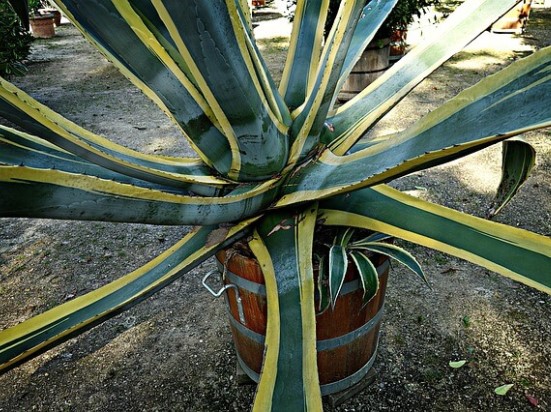
6.3 Watering the agave
Sufficiently drought-resistant plant, in winter almost before drought, once every 1 - 2 months.
In the summer - as the earthen coma dries up, about once a week.
In no case should water get into the plant and stand in the outlet.
Small agaves need regular watering, and as they age, plants will find it easier to tolerate drought.
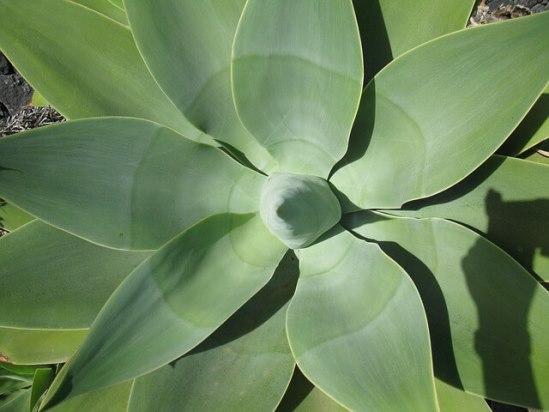
6.4 Soil
As for desert plants - with a high content of coarse sand, well-drained with expanded clay, perlite or brick chips - garden soil, coarse sand, peat. Alkaline enough - pH 6.8 - 7.
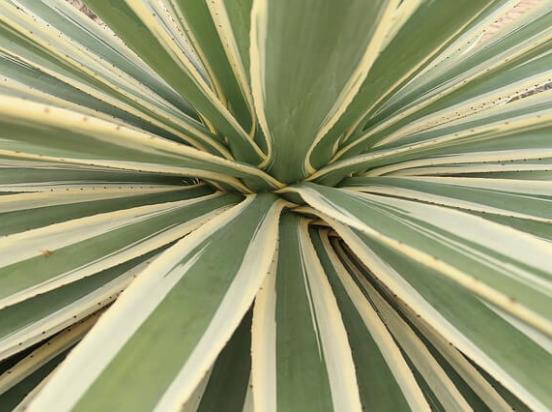
6.5 Home Maintenance - Lighting
The plant is light-loving, only some species can tolerate low light. From a lack of light, the leaves can droop and become weak.
Indoor agave is a succulent that can be grown for a long time without natural light, which makes it possible to use them for landscaping rooms without windows (hallways, corridors, bathrooms, etc.).
It is recommended to use LED or fluorescent lamps as a light source for the listed crops, which should be turned on for 14-16 hours a day.

6.6 Top dressing
A low concentration fertilizer is suitable for a plant, poor in nitrogen - about ½ of the usual one in the spring and summer.
Feed about 2 times a month, it is better not to overfeed.
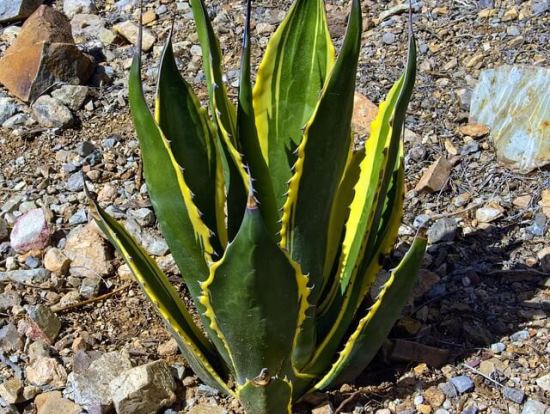
6.7 Spraying
The plant does not need spraying and easily tolerates dry room air, however, it welcomes the ventilation of the room.
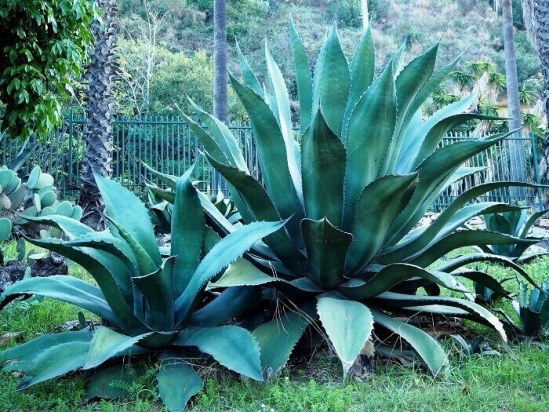
Care
As a plant, agave is unpretentious, but this does not exclude the observance of certain rules for care. They will vary depending on the period. So, in spring - summer, the plant is in a phase of active growth and development, and in autumn - in winter it enters a dormant stage.
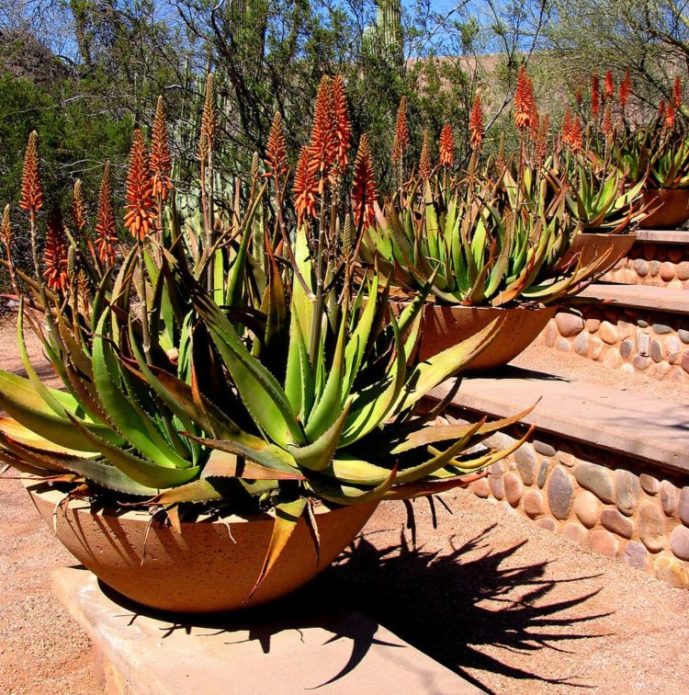
Inflorescences bloom at the tops of long peduncles
Watering and feeding
Agave is watered moderately throughout the spring-summer period with a frequency of 1 time per week. In this case, boiled and settled water is used. The ideal option is rain or river water. They try not to get it on the leaves (this leads to burns). And they also do not allow the creation of swampiness, therefore they moisten as the top layer of the soil dries up. It is not necessary to spray the plant. In autumn and winter, the frequency of irrigation is reduced to a minimum - irrigate only when the upper soil layer is completely dry.
Top dressing begins in early spring with a frequency of 2 times a month. At the beginning of autumn, they switch to the schedule - once a month, and with the onset of winter, they completely stop fertilizing. They use complex mineral compositions intended for succulents and cacti, with a low nitrogen content. For dosages, they are guided by the attached instructions.
Table: care errors and their correction
During agave care errors on the part of the grower are likely, which lead to certain negative consequences.
| Painful manifestations | Causes | Correction methods |
| Excessive stretching of leaves | Lack of light | Change the location of the flower |
| Leaves wither and wrinkle | Excess moisture | Normalize the irrigation regime |
| The foliage turns yellow at the ends | Dry air or too much calcium in the soil | The succulent is placed on a pallet with wet moss or a container with water is placed next to it. Less commonly fed |
| Leaves lose their fleshiness and juiciness | Lack of moisture | Increase the amount of hydration |
| Dark spots appear on the leaf plates | Prolonged exposure of the plant to direct sunlight | Creates light shading |
| The growth of the outlet is inhibited | Little lighting | Move the pot closer to the window |
Temperature regime
The temperature in the room should not be lower than 18 ° C, the upper threshold is 28 ° C. Agave is a thermophilic plant, an apartment or house must be well heated for the plant to feel comfortable.
If you have a high heat from the batteries, hang a thermometer next to the window opening. But rarely when additional protective measures are necessary, agave loves warmth and grows better in it.
Airing is useful for the flower, but if the degrees drop to 10 ° C, agave may die.
Air humidity level
You do not need to spray the flower. Do not put bowls in water or a humidifier next to it. Usually in apartments dry air, which is almost native to the agave in its natural habitat.
If the outlets become dusty, you can wipe them with a damp cloth or rinse them with warm water. Do not forget to dry the outlets after that, otherwise stagnant water will cause rotting of leaves and roots.
Application
Mn. species, especially A. sisal (A. sisalana), are used for fiber, papermaking, and also in medicine.
Use in landscape design
Agave is a perennial plant with succulent thick green or green-variegated large leaves. There are thorns along the edges of the leaves. The leaf blade ends with a subulate hard point. In natural conditions, plants grow to large sizes. The diameter of the rosette of some species reaches 4-5 m, and the rosette of the smallest, dwarf, agaves is no more than 3-4 cm. In most cases, agaves bloom once in a lifetime, after which they gradually die over several months. L.) is a type of agave grown in room culture. It is an ornamental plant with bluish green leaves. It is similar in appearance to aloe, but does not have a stem.
Collection and processing of medicinal raw materials
For medicinal purposes, the leaves of a three-year-old and older plant and fresh juice are used. By evaporation, thickening and hardening, the juice of the leaves, when rubbed, gives a yellow-green powder with a peculiar smell and bitter taste.
Application in official and traditional medicine
Agave preparations are used internally and externally. Inside - for diseases of the stomach, liver, lungs. For internal diseases, agave is used in the form of an infusion or tincture from fresh crushed leaves, and for liver diseases - in the form of a powder.
Externally used in the form of compresses for wounds, abscesses, etc. Leaves for external use are used fresh - splitting the sheet and applying it to the sore spot with the cut side.
Agave preparations can cause increased motility of the colon, so the plant is used as a laxative. Agave has analgesic, antipyretic, disinfecting, expectorant and anti-inflammatory effects. It improves the metabolic process, promotes the removal of excess fluid from the body, rapid healing of irritations of various tissues, normalizes the activity of the digestive system, mammary gland, and gallbladder.Tincture of American agave leaves is used to treat rheumatism, as well as for neuralgia, radiculitis, sciatica, and headaches.
Therapeutic action:
- 1 wound healing
- 2 anti-inflammatory
- 3 antiseptic
- 4 disinfectant
- 5 anthelmintic
- 6 laxative
- 7 choleretic
7 diseases and pests
Root decay is possible with excessive watering.
Harmful insects - mealybugs, aphids, spider mites, thrips, rarely - scale insects.
Insects are pests
| Insect name | Signs of infection | Control measures |
| Mealybug | The surface of the leaves and shoots is covered with fluffy, cotton-like white bloom. Plants are lagging behind | Folk remedies: spraying with soap and alcohol solution. Infusion of tobacco, garlic, cyclamen tubers, alcohol treatments, pharmaceutical tincture of calendula proved to be good. Chemicals: green soap solution, Actellik, Fitoverm. |
| Spider mite | Subtle spider webs on the leaves, yellowing and foliage falling off with extensive lesions. The surface of the sheet plates becomes dead and covered with small cracks. Plant development slows down. | Folk ways. Plants can be rinsed in the shower and left in the bathroom in a humid atmosphere for half an hour. Irradiation with an ultraviolet lamp every week for 2 minutes. Chemical preparations based on pyrethrum, sulfur powders, Fitoverm, Actellik. |
| Aphid | Sticky droplets appear on the leaf plates, the leaf plates curl and deform, delicate buds and young leaves wither. Insect colonies can be seen on the tops of the shoots, buds or the underside of the leaf plates. The flowers of aphid-infested plants may become deformed. | Folk methods: infusion of nettle, decoction of rhubarb leaves, wormwood, soap solution, infusion of tobacco and dandelion, onions, marigolds, yarrow, tansy, dusting with wood ash. Chemical preparations: Sulfur powders, green mass treatment with green potash soap without getting into the ground, Decis, Aktellik, Fitoverm. |
| Thrips | The appearance of yellow spots on the leaf blades, small brown dots can be observed on the underside of the leaves. When spread, the pests cause the leaves to turn yellow, dry and fall off. | Folk ways. Increase the humidity of the air, wipe the surface of the leaves with soapy water to reduce the number of pests. Preparations based on pyrethrum - 2-fold treatment with an interval of 7 - 10 days, spraying with tobacco infusion, infusion of yarrow or Persian chamomile, decoction of cyclamen tubers. Chemical preparations: dusting with sulfur powders, the use of anabazine - sulfate in a soapy solution. |
| Shield | Sticky droplets on the leaves, small yellow spots on the surface of the leaf plates. With a large spread of scale insects, they contribute to the drying and falling of leaves. Flowers slow down their development | Folk methods of struggle. Spraying with soap and alcohol solution. Scabbard larvae do not like garlic infusion; they also use pyrethrum-based products. Chemicals. Fitoverm, Aktellik, Fufanon. |
-
Mealybug
-
Shield
-
Spider mite
-
Aphid
-
Thrips
What is a succulent
The homeland of the agave subfamily is the desert and rocky areas of Central America. Up to 300 plant species can be found in these parts. In temperate climates, succulents are grown only in greenhouse conditions or as a pot culture.
In the parks of the southern and greenhouses of the northern part of Russia, American agave is most often found. The plant looks like this:
- The stem is very short and difficult to identify.
- In transverse diameter, this species reaches 3-4 m.
- An adult plant is a rosette of leaves. On young specimens, the tips are in the form of a pointed tube. This is clearly visible in the photo.
- The main color of the leaves is green, but variegated varieties are found.
- Peduncle - arrow 6-12 m long.There are up to 17 thousand tiny, green-yellow buds per plant.
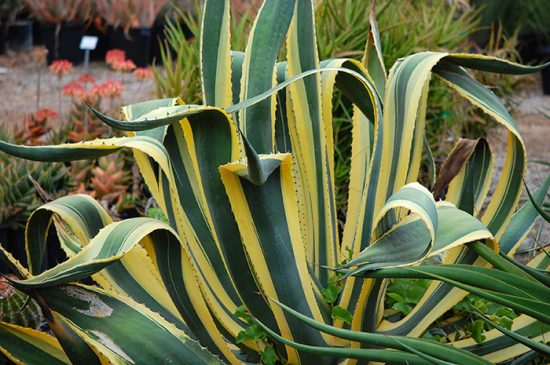
As a representative of succulents, agave "stores" water in the leaves, so the plates are thick and fleshy. The substances contained in the tissues have a therapeutic effect on the human body. At home, as well as in some areas of the Mediterranean, India, Sri Lanka, agave is cultivated as a medicinal plant.
The leaves are used for both household and food purposes. Using various technologies, ropes, rugs, and paper are made from agave plates. Alcoholic drinks are made from succulent juice: pulque and mezcal.
Agave care at home
An adult agave is quite large. Therefore, dwarf species are most often chosen for growing in indoor conditions, or agave is grown while it is young.
Illumination
This plant simply adores light and will not be damaged by the direct rays of the sun. Remember, the more light the agave gets, the better. If she lacks light, then her leaves will become very small, and the plant itself will stretch out. This should be taken into account in winter, when the days are much shorter and there is less sunshine.
Temperature regime
In the warm season, it is recommended to move the agave to fresh air, and if possible, plant it in open ground. However, she will feel good at home at normal room temperature. Agave is not afraid of summer heat, which distinguishes it from most other house plants.
In the winter season, this plant must be placed in a room where the temperature will be in the range of 4-10 degrees.

How to water properly
In the summer, water the plant moderately and regularly. It is impossible to allow both overflow and drying out of the earthen coma. In winter, however, watering is highly dependent on the wintering conditions of the agave. In the event that it is not possible to provide her with a cold wintering, then watering should be carried out in the same way as in the warm season. If the plant is provided with a cold wintering, then watering should be significantly reduced. In any case, the following feature must be taken into account - the soil must necessarily dry out, however, prolonged overdrying should in no case be allowed. Remember, it's better to overdry than overflow.
So, if the room is cool, and the soil in the flower pot is constantly moist, there is a high probability of stem and root rot.
Top dressing
Agave feeding is carried out only in the warm season, or rather, from May to early September. The plant is fertilized once every 4 weeks. For feeding, as a rule, they use general fertilizer for succulents or special fertilizer for cacti. In winter, it is forbidden to apply fertilizer to the soil.
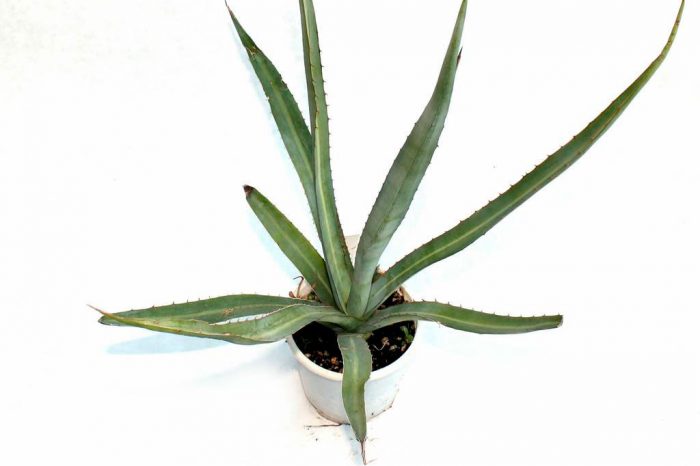
How to transplant
A very young plant, until it reaches the age of four, must be transplanted every year. An adult agave is subjected to this procedure less often, or rather, once every 2 or 3 years. And this is a prerequisite if you want your home to be decorated with a lush and very spectacular bush.
For transplanting, you can use purchased soil intended for cacti. If you have a desire, then you yourself can make a suitable soil mixture for this. You need to mix leaf and clay-turf soil, as well as sand in a 1: 3: 1 ratio.
Don't forget about good drainage.
Reproduction methods
Agave can be propagated in different ways, but most often they use offspring or cuttings of rhizomes for this. However, it is quite possible to grow it from seeds, but it is worth considering that this is much more difficult and longer.
4 flowering time
Flowering is a truly impressive sight, but at home it rarely blooms, the plant must reach 10 or even 30 years in order to bloom.
During flowering, many species emit an enchanting aroma, but flowering can be over in just half an hour.
After a period of flowering and fruiting, the plant may die due to the withering away of the rosette.
Peduncle up to 8 m long is crowned with a huge panicle inflorescence with thousands of flowers of various colors.
The onset of flowering varies for different varieties and species.

Reproduction
Daughter rosettes, lateral offspring in April - June.
Seed propagation is possible in early spring at 20 - 25 ° C, but it will take a lot of time. The germination process takes about 2 weeks at a temperature of about 22 ° C.
The lateral offshoots take root in the sand, beforehand, the cut site must be dried up within 1 - 2 days.
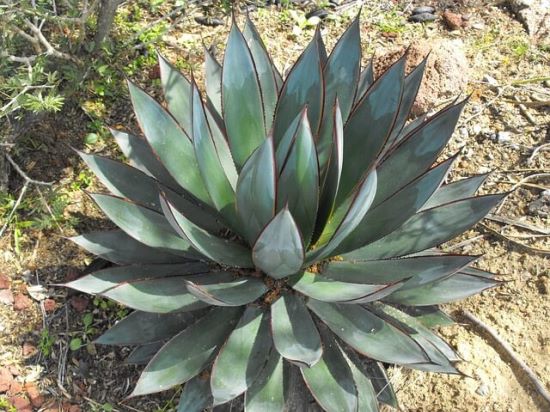
How to plant an agave, plant propagation
If you remember where agave grows in the wild (on poor sandy-rocky soils), then before planting you need to take care of the appropriate soil mixture. The best option is a mixture of humus, coarse sand, leafy and sod land (ratio - 1: 0.5: 1: 2).
You can use ready-made primers:
Experienced florists and avid florists believe that the topsoil where a flower such as agave grows should consist of large brick chips, which will increase the drainage function of the substrate. As a container, for agave choose wide and low ceramic pots with holes in the bottom. The bottom layer (2-3 cm) should consist of small pebbles or gravel.
Important! In the first days after planting, the agave must be protected from direct sunlight. Indoor agave can propagate by seeds or shoots
Indoor agave can propagate by seeds or shoots.
Seed planting
This method of propagation cannot be called the best, since plants obtained from seeds develop slowly. For cultivation, it is necessary at the end of winter to place the seeds in wet sand to a depth of 1 cm. The container is then covered with foil or glass. The temperature must be kept between 20-25 ° C. Shoots will appear in 5-7 days. 15-20 days after the appearance of the first leaf, the second begins to grow, after another 20 days - the third, and after 2 weeks the agave will be 8 cm high and 15 cm in diameter. At the same time, the plant grows a third root, and after another 20 days a fourth leaf will appear and a rosette is formed.
Propagation by cuttings of rhizomes
Indoor agave flower can be grown from cuttings, for which they are pruned at the base during transplantation.
Important! Each cutting must have at least one bud. After cutting, the cuttings are dried for 2-3 hours.
To speed up growth, you can sprinkle crushed charcoal on the cut. The prepared cuttings should be planted in the prepared soil (sand), and then watered (the water should be at room temperature). In the first year of life, a young plant throws out up to six leaves, in the second - up to nine, and in the third - up to twelve
After cutting, the cuttings are dried for 2-3 hours. To speed up growth, you can sprinkle crushed charcoal on the cut. The prepared cuttings should be planted in the prepared soil (sand), and then watered (the water should be at room temperature). In the first year of life, a young plant throws out up to six leaves, in the second - up to nine, and in the third - up to twelve.
How to grow agave from root and stem suckers
The houseplant agave can reproduce by lateral and root suckers, transplanting and further care of which is also not difficult. When children appear, they are carefully separated with a sharp blade, dried during the day and placed in a separate container with a mixture prepared in advance. You do not need to cover and spray the seedling. The first watering should be no earlier than 3 days later. Yes, and before the rooting of the flower, it is extremely rare to water it.
Important! It should be remembered that agave can grow to a large size, so it is better to grow dwarf varieties in apartments.
Agave species
For cultivation in greenhouses, greenhouses and indoor conditions, several dozen species of agave are suitable, which are distinguished by slow growth and compact size. It is relatively easy to grow them. The following types of agave are most common in culture:
|
Species name |
Description and features |
| American agave | One of the largest indoor agave species, reaching a height of 2 meters. Leaves of the usual lanceolate-linear shape, painted in a solid green color. The base of the leaf plates is covered with thorns. A lot of peduncles are formed on the plant - with proper care, up to 35 pieces. The height of flower stalks in nature and when grown in a greenhouse can reach 8-9 meters. It is noteworthy that the peduncle can grow for five years. |
| American edged agave | A species with a short stem and long leaves (up to 2 meters), the width of which reaches 20 cm. The leaves are painted in dark olive color, and along the edge they are decorated with a light yellow border. A large semi-lignified needle is located at the end of the leaves. |
| American Decorated Agave | In appearance, the plant is similar to edged agave, but differs in more compact size and the arrangement of light stripes - they adorn the central part of the leaf plate |
| Compressed agave | A Mexican variety of agave, characterized by lush globular rosettes, consisting of fleshy, upright narrow leaves with a slight curvature at the end. Forms a pedicel up to two meters in height |
| Queen Victoria Agave | The most popular indoor type with compact outlet sizes. Leaves up to 15 cm long and up to 7 cm wide. leaves olive green with a wavy strip of light olive color along the edges. The tip of the leaves is crowned with a thorn |
| Tumi | Medium-sized bush, consisting of rounded, slightly pointed at the end leaves up to 25 cm in diameter... The leaves are colored light olive. The plant is decorated with filamentous spines that cover the edges of the leaf plates. There is a hard thorn at the top of the leaf |
| Parasian agave | View with oval-oblong leaf plates of a matte green color. The tips of the leaves are dotted with smooth brown needles |
| Agave potatorum | A very compact type of agave with oval, scapular green leaves. The spines at the ends of the leaves are colored brown |
| Agave is terrible | View with serrated leaves growing up to 40 cm in length. Thanks to this shape, the leaves resemble the jaws of a crocodile (perhaps that is why the species got this name). The peduncle, with proper care, reaches 3 meters in height |
| Agave Funka | View with lanceolate leaves, slightly tapered base and pointed tip. The color of the leaf is green, and along the edge - with a slight bluish tint. The edge of the leaf is decorated with short blue thorns |
Interesting facts about agave
Only the Agava azul or tequila agave variety is used for the production of the famous drink.
Even the country of Mexico bears its name in honor of this exotic plant, and the literal translation sounds like "the place of the agave."
Agave does not bloom in rooms, but in greenhouses you can wait for the flowering process in 20–30 years, compared to the natural environment - 10–15 years.
Since the sheet plates are quite rigid, some types of agave are used to make ropes, ropes or rugs, the leaves also serve as raw materials for the production of packaging and other rough fabrics, and paper products are made from production waste. In ancient times, the fiber from the leaves was used by the Indians as threads for sewing clothes, and the needle at the tip was attached by nature itself - the leaf plate is terminated by a sharp agave thorn.
The properties of agave have not yet been fully studied by doctors and scientists, but the leaves of the plant contain many useful substances, micro- and macroelements, dietary fiber and carbohydrates.
Agave juice and leaves have long been used in folk medicine.If you use them for external compresses, it will contribute to the resorption of hematomas or hemorrhages under the skin. With their help, wounds heal faster, inflammatory symptoms are relieved and pain sensations decrease. If you use the juice inside, then there is a diuretic and laxative effect on the body, and it is more delicate than the action of the same sabur. Preparations made on the basis of agave parts help to normalize metabolic processes in the body and improve digestion.
However, there are contraindications when using products with the use of agave. For example, the sap of a plant has pronounced irritating and caustic properties and must be carefully diluted during use as indicated in the specific case. It is necessary to use it very carefully for people who have liver disease, exacerbated inflammatory processes of internal organs, or in the presence of bleeding inside the body.
Agave should not be used by men who want to have children, since the sap of the plant is characterized by depressing reproductive functions (spermatogenesis). If a person's skin is highly sensitive, then even a chemical burn is possible.
It is also used to cure the following diseases: conjunctivitis, jaundice, manifestations of gout and osteochondrosis, spondylosis and gastrointestinal diseases. From the skin it cures abscesses and boils, dropsy (ascites) and removes furunculosis.

